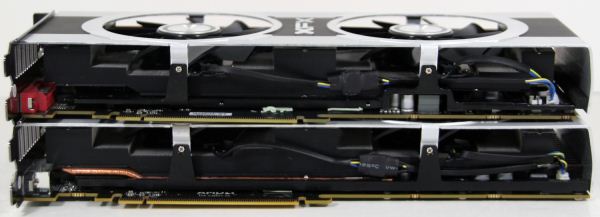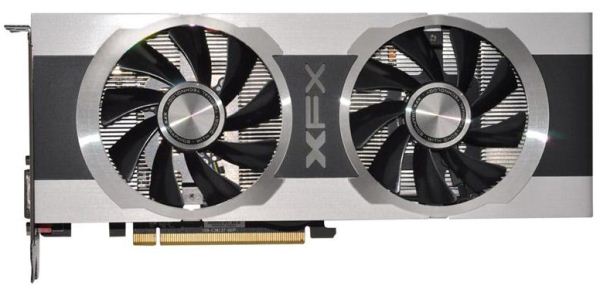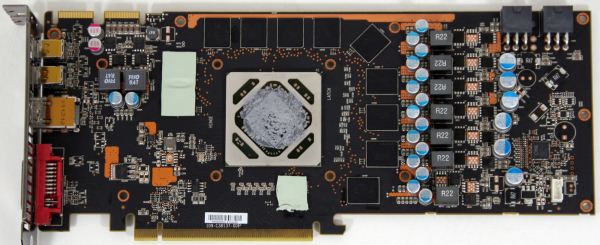AMD Radeon HD 7950 Review Feat. Sapphire & XFX: Sewing Up The High-End Market
by Ryan Smith on January 31, 2012 9:02 AM ESTMeet the XFX R7950 Black Edition Double Dissipation
Our second partner card of the day is XFX’s R7950 Black Edition Double Dissipation. Like the 7970 Black Edition Double Dissipation we reviewed earlier this month, the 7950 BEDD is a factory overclocked card (Black Edition) using XFX’s Double Dissipation cooler.
Starting with the overclock, XFX is shipping the 7950 BEDD with a core clock of 900MHz and a memory clock of 5.5GHz. This represents a 100MHz (12.5%) core clock overclock and 500MHz (10%) memory clock overclock, putting it just shy of the 925MHz core clock the 7970 ships at.
In terms of construction like all of the other 7950 cards launching today XFX is using AMD’s 7950 PCB. This means the PCB measures 10.25” long and features 2 6pin PCIe power sockets towards the rear of the card, while at the front the card uses the AMD standard port configuration of 1 DL-DVI, 1 HDMi, and 2 mini-DisplayPorts. The one notable deviation here from the Sapphire card is that XFX has not included a BIOS selection switch, so the card lacks any kind of ability to easily recover from a bad BIOS flash, and if unlocking proves viable it would not be a good candidate for the process.
Meanwhile cooling is provided by XFX’s Double Dissipation cooler. This is the same heatsink and fan assembly we saw with the 7970 BEDD, which makes this an open air cooler using a pair of fans to push air along an aluminum heatsink running almost the entire length of the card. Because it’s the same assembly, the shrouding for the card sticks out over the end of the PCB, negating the benefit of the shorter 7950 PCB and making the card 10.65” long just like the 7970 BEDD.

Top: 7950 BEDD. Bottom: 7970 BEDD
Do note that while it uses the same fan and heatsink assembly, Double Dissipation does not mean it uses the same vapor chamber assembly to transfer heat from the card. Where the 7970 BEDD used a fairly large vapor chamber, the 7950 BEDD uses a much smaller vapor chamber that only makes contact with roughly half of the heatsink, meaning that heat isn’t being transferred to the extremities of the heatsink nearly as well on the 7950 BEDD. Furthermore the aluminum plate covering the RAM and MOSFETs is poorly sized, leaving parts of the RAM chips (and their thermal pads) exposed. We’ll see how this plays out when we get to our testing, but the 7950 BEDD is clearly not as well built as the 7970 BEDD.
Rounding out the package is the same collection of extras that we saw in the 7970 BEDD. Inside you’ll find the usual driver CD and quick start guide, along with a metal XFX case badge, a mid-length CrossFire bridge, and a passive HDMI to SL-DVI adaptor. All of this is packed in one of XFX’s pleasantly small boxes, which doesn’t use much more space than the card itself.
The MSRP on the 7950 BEDD is $499, $50 over the MSRP for a regular 7950 and making it one of the more expensive 7950s launching today. XFX is offering a base 2 year warranty on the 7950 BEDD, which can be extended to a lifetime warranty by registering the card within 30 days of purchasing it.












259 Comments
View All Comments
Shadowmaster625 - Tuesday, January 31, 2012 - link
Well some of us do care about noise and power consumption. That sapphire card runs very cool and quiet, nearly silent in fact. It uses 30 less watts at typical idle and nearly 100 watts less than a 580 while gaming. That's about a penny per hour of gaming. Power savings could easily reach $40 over two years of gaming, plus another $30 if you leave your pc on 24/7, for a total of $70 saved over two years.Thats is about what one year of technological advancement is worth.
SlyNine - Tuesday, January 31, 2012 - link
Because in part the 480/580 are dogs in regards to power consumption. My 5870 idles at nearly the same and only uses a bit more under load. It is also 2 1/2 years older.AssBall - Tuesday, January 31, 2012 - link
You do realize that the parts you have "execs jumping out of windows" about account for maybe 1/200th of the companies income? Guess not.chizow - Tuesday, January 31, 2012 - link
Actually I think these parts will make up an overwhelming % of the company's income given their graphics division is one of the few within AMD that consistently turns a profit. But I guess I actually know what "income" is and how its calculated. Given these parts sell for 50% higher price than any single-ASIC SKU (CPU or GPU) in the last 5 years, I think there's a good chance these parts will make up the bulk of their profit for the quarter.You really think AMD is turning some amazing profit on their free AR Bulldozer promos or happy meal priced APUs when they struggle to make a profit on a quarterly basis? There's break-even (90-95% of their revenue) and then there's parts like this that actually sell for a profit. They don't need to sell high volume on these parts when the ASP and margins are so healthy.
repoman27 - Tuesday, January 31, 2012 - link
Actually, you should try reading AMD's Q4 earnings report which was just posted here: http://www.anandtech.com/show/5465/amd-q411-fy-201...The graphics division only accounted for 8.4% of AMD's operating income for fiscal 2011, if you ignore the accounting monkey business regarding GloFo.
Of that 8.4%, about half is likely attributable to FirePro because the gross margins for professional and compute solutions are easily double that of consumer GPUs.
While the ASP's and gross margins on enthusiast cards are great compared to the high volume consumer stuff, they still represent a niche market, and realistically less than 3% of AMD's 2011 operating income.
chizow - Wednesday, February 1, 2012 - link
I have read it and it obviously doesn't include any significant Tahiti or 28nm parts, since they only started to ship the first few units for revenue for that Jan 7th 7970 launch.As stated in the article:
"while the first true 7000 series part (Tahiti) did not launch until 2012 and only started shipping for revenue very late into 2011. Still, it was enough to have a significant impact on AMD’s GPU ASP, increasing it over 2010’s ASP even with the limited number of new products."
Obviously projected revenue will be much higher with a full quarter at these prices.
But yes the rest of your post confirms my point, if you want to point to FirePro I can already guarantee you they will sell more 7970 consumer desktop parts than any FirePro parts using the same ASIC, we're not talking about Quadro here lol.
At $450-600, that's already a HUGE markup and increase in their gross margins compared to any previous single-ASIC desktop SKU, so its obviously going to result in a huge increase in profits.
And no you can't just discount that "GloFo" business, if the rest of the company loses money because of poor supplier/pricing decisions and selling prices and the other consistently makes money and represents the bulk of the company's income.
repoman27 - Wednesday, February 1, 2012 - link
Seriously, put down the crack pipe.Have you ever looked at the relative prices of consumer desktop parts vs. FirePro parts based on the same chip? Yes, they will sell a lot more of the consumer parts, and yet they will still make more profit on the fewer FirePro parts sold. So when AMD wholesales chips to partners so the partners can produce cards that end up retailing for $450-600, you believe their gross margins are higher than when they sell a FirePro V9800 directly to a retailer who turns around and sells it for $2800?
Why are you so convinced that the difference in retail release prices for the 7 series and 6 series is solely attributable to AMD expanding their gross margin? The 7 series is being offered for 50% more than the 6 series was, and yet the transistor count increased by over 62%. Not to mention that these are the first parts produced on the new 28nm node, so yields are probably less than stellar at this point, despite what TSMC might have us believe.
Furthermore, the GloFo business is germane to both the CPU and GPU divisions. Graphics accounted for less than a quarter of AMD's overall revenue for 2011 and only 8.4% of their income, no matter how you want to look at it. All I omitted was the one time charges that AMD took for the decrease in value of their stake in GloFo and the costs associated with their corporate restructuring.
No matter what you believe, 8.4 is a larger number than 91.6. Hang it up, you're flat out wrong.
chizow - Thursday, February 2, 2012 - link
No, you need to put down the "crack pipe."You're using past performance to define FUTURE revenue forecasts, which is what my statement was about. That's the whole point, the GPU division WAS disappointing in 2011, but ASP and profit increased year over year in Q4 based on the high ASP of the few Tahiti parts that shipped in December.
Obviously Tahiti parts will have a bigger impact on both numbers in Q1 '12 with a full 3 quarters and volume shipment at these high ASPs which is exactly what I stated.
As for why I think the difference in 7 and 6 series pricing was the difference in segment margins? Because I know how to read financial statements and MD&A. 11/12 months with DECLINING revenue and margins selling only 6 series and specifically cited by AMD caused by declining sales and ASP on their desktop and shortages of their Llano mobile parts. Then in Q4, despite declining revenue sequentially and y2y, their ASP, margins and profit increases. Do you think this is a result of their 6 series which spent the whole year declining in sales and margin, or the 7 series that sell for 50-100% more than their previous products? Hmmm.....
Now what do you think is going to happen with a full 3 quarters at the same prices for the graphics division? What do you think is going to happen to the company's financials given they are predicting a gloomy outlook with predicted 8% decrease in revenue sequentially? I can already guarantee you the graphics division will be profitable, maybe ~$100M, but the CPU division will at best break even if they don't post a loss. Which brings us full circle to the comment you and others apparently had issue with:
Actually I think these parts will make up an overwhelming % of the company's income given their graphics division is one of the few within AMD that consistently turns a profit.
repoman27 - Wednesday, February 1, 2012 - link
And clearly I meant to say that 8.4 is NOT a larger number than 91.6.Sunburn74 - Tuesday, January 31, 2012 - link
I think the power.consumption reductions are quite significant and eventually may be passed onto the mobile space.